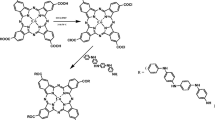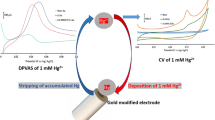Abstract
The design and development of new catalysts with low cost, high selectivity, and sensitivity for the electrochemical sensor applications is of huge interest. In this report, novel zinc tetra [4-[2-(1H-benzimidazol-2-yl) phenoxy]] phthalocyanine (ZnTBImPc) is prepared in a pure state with 87% yield. The characterization of the ligands and complex is carried out by combination of techniques like elemental analysis, ultraviolet–visible (UV–Vis), Fourier-transform infrared spectroscopy (FTIR), mass spectral, thermogravimetric analysis (TGA), X-ray diffraction (XRD), and electrochemical techniques. FTIR is useful in monitoring the progress of the reaction. The benzimidazole moiety of ZnTBImPc undergoes electropolymerization and thin, uniform polymeric layer deposits on the glassy carbon surface. The polymeric film was characterized by impedance spectra and charge transfer studies. The fabricated polymeric film electrode is applied for voltammetric sensing of ammonia which showed linear characteristics in 0.1 to 1.0 µM concentration range. The LOD was 30 nM with sensitivity of 237.25 µA µM−1 cm−2. The efficiency and sensitivity of ammonia oxidation at the poly(ZnTBImPc) are compared with the composite hybrid electrode of poly(ZnTBImPc) and carbon nanoparticle (CNP). The amperometric sensing of ammonia showed linear behavior in 50 to 500 nM concentration range. The RDE experiment revealed that the number of electrons involved in the ammonia oxidation is nearly 3. The polymeric electrode was subjected to the interference studies to evaluate the selectivity of the fabricated electrode and found that the co-existing molecules do not show interference during the detection of ammonia.
Graphical abstract
Schematic representation of electro-oxidation and detection of ammonia













Similar content being viewed by others
References
Sizun T, Bouvet M, Suisse JM (2012) Humidity effect on ammonia sensing properties of substituted and unsubstituted cobalt phthalocyanines. Talanta 97:318–324
Volkow ND, Gur RC, Wang GJ et al (1998) Association between decline in brain dopamine activity with age and cognitive and motor impairment in healthy individuals. Am J Psychiatry 155:344–349
Malenka RC, Nestler EJ, Hyman SE, Sydor A, Brown RY (2009) Molecular neuropharmacology: a foundation for clinical neuroscience, 2nd edn, vol 147–48: 366–367, 375–376. McGraw-Hill Medical, New York
Rahman MM, Balkhoyor HB, Asiri AM, Marwasni HM (2016) A gold electrode modified with silver oxide nanoparticle decorated carbon nanotubes for electrochemical sensing of dissolved ammonia. Microchim Acta 183:1677–1685
Berridge KC, Robinson TE, Aldridge JW (2009) Dissecting components of reward: “liking”, “wanting”, and learning. Curr Opin Pharmacol 9:65–73
Ding H, Cai Y, Chen J et al (2019) Cryodesiccation-driven crystallization preparation approach for zinc(II)-phthalocyanine nanodots in cancer photodynamic therapy and photoacoustic imaging. Microchim Acta 186:2–9
Hahn U, Engmann S, Oelsner C et al (2010) Immobilizing water-soluble dendritic electron donors and electron acceptors—phthalocyanines and perylenediimides—onto single wall carbon nanotubes. J Am Chem Soc 132:6392–6401
Denisha G, Nolwazi N, Werner E (2020) Recent advances in phthalocyanines for chemical sensor, non-linear optics (NLO) and energy storage applications. Coord Chem Rev 420:213359
Imadadulla M, David O, Manjunatha N, Lokesh KS, Tebello N (2019) Investigation of novel substituted zinc and aluminium phthalocyanines for photodynamic therapy of epithelial breast cancer. Dyes Pigments 170:107592
Keshavananda Prabhu CP, Manjunatha N, Muthumuni M, Tebello N, Lokesh KS (2021) Symmetrically substituted Zn and Al phthalocyanines and polymers for photodynamic therapy application. Front Chem 9:331
Nilotpal B, Biswajit N, Abhijit G, Gopal D (2019) A benzimidazole-based non-symmetrical tripodal receptor for the ratiometric fluorescence sensing of fluoride ions and solid state recognition of sulfate ions. New J Chem 43:16497
Sahar Z-A, Maryam SM, Omid A, Masoud S-N (2020) Green synthesis of dysprosium stannate nanoparticles using Ficus carica extract as photocatalyst for the degradation of organic pollutants under visible irradiation. Ceram Int 46:6095–6107
Mugadza T, Nyokong T (2010) Synthesis, characterization and the electrocatalytic behaviour of nickel (II) tetraamino-phthalocyanine chemically linked to single walled carbon nanotubes. Electrochim Acta 55:6049–6057
Moraes FC, Golinelli DLC, Mascaro LH, MacHado SAS (2010) Determination of epinephrine in urine using multi-walled carbon nanotube modified with cobalt phthalocyanine in a paraffin composite electrode. Sens Actuators B 148:492–497
Zhang T, Mubeen S, Myung NV, Deshusses MA (2008) Recent progress in carbonnanotube-based gas sensors. Nanotechnology 19:2001
Bondavalli P, Legagneux P, Pribat D (2009) Carbon nanotubes based transistors as gas sensors: state of the art and critical review. Sens Actuators B 140:304–318
Keshavananda Prabhu CP, Nemakal M, Aralekallu S et al (2019) A comparative study of carboxylic acid and benzimidazole phthalocyanines and their surface modification for dopamine sensing. J Electroanal Chem 847:113262
Palanna M, Mohammed I, Aralekallu S, Nemakal M, Sannegowda LK (2020) Simultaneous detection of paracetamol and 4-aminophenol at nanomolar levels using biocompatible cysteine-substituted phthalocyanine. New J Chem 44:1294–1306
Verma AL, Saxena S, Saini GSS et al (2011) Hydrogen peroxide vapor sensor using metal-phthalocyanine functionalized carbon nanotubes. Thin Solid Films 519:8144–8148
Özgül G, Taştemel A, Özkaya AR, Bulut M (2015) Synthesis, characterization and comparative electrochemistry of beta and alpha tetra-[4-oxy-3-methoxybenzoic acid]-substituted Zn(II), Co(II) and Cu(II) phthalocyanines. Polyhedron 85:181–189
Hu YF, Zhang ZH, Bin ZH et al (2012) Sensitive and selective imprinted electrochemical sensor for p-nitrophenol based on ZnO nanoparticles/carbon nanotubes doped chitosan film. Thin Solid Films 520:5314–5321
Keshavananda Prabhu CP, Manjunatha N, Shambhulinga A et al (2019) Synthesis and characterization of novel imine substituted phthalocyanine for sensing of L-cysteine. J Electroanal Chem 834:130–137
Fashedemi OO, Ozoemena KI (2011) A facile approach to the synthesis of hydrophobic iron tetrasulfophthalocyanine (FeTSPc) nano-aggregates on multi-walled carbon nanotubes: a potential electrocatalyst for the detection of dopamine. Sens Actuators B 160:7–14
Aralekallu S, Mohammed I, Manjunatha N et al (2019) Synthesis of novel azo group substituted polymeric phthalocyanine for amperometric sensing of nitrite. Sens. Actuators B 282:417–425
Gaudillat P, Jurin F, Lakard B et al (2014) From the solution processing of hydrophilic molecules to polymer-phthalocyanine hybrid materials for ammonia sensing in high humidity atmospheres. Sensors (Switzerland) 14:13476–13495
Sajjan VA, Aralekallu S, Nemakal M, Palanna M, Prabhu CPK, Sannegowda LK (2020) Nanomolar detection of lead using electrochemical methods based on a novel phthalocyanine. Inorg Chim Acta 506:9564
Nyokong T, Vilakazi S (2003) Phthalocyanines and related complexes as electrocatalysts for the detection of nitric oxide. Talanta 61:27–35
Aralekallu S, Sajjan VA, Palanna M et al (2020) Ni foam-supported azo linkage cobalt phthalocyanine as an efficient electrocatalyst for oxygen evolution reaction. J Power Sources 449:227516
Gao F, Cai X, Wang X et al (2013) Highly sensitive and selective detection of dopamine in the presence of ascorbic acid at graphene oxide modified electrode. Sens. Actuators B 186:380–387
Prabhu CPK, Aralekallu S, Sajjan VA, Palanna M, Kumar S, Sannegowda LK (2021) Non-precious cobalt phthalocyanine-embedded iron ore electrocatalysts for hydrogen evolution reactions. Sustain Energy Fuels 5(5):1448–57
FernandoC M, Murilo FC, Sergio ASM, Lucia HM (2008) Electrocatalytic behavior of glassy carbon electrodes modified with multiwalled carbon nanotubes and cobalt phthalocyanine for selective analysis of dopamine in presence of ascorbic acid. Electro Analysis 20:851–857
Aralekallu S, Palanna M, Hadimani S, Prabhu CPK, Sajjan VA, Thotiyl MO, Sannegowda LK (2020) Biologically inspired catalyst for electrochemical reduction of hazardous hexavalent chromium. Dalton Trans 49:15061–15071
Lokesh KS, Shambhulinga A, Manjunatha N et al (2015) Porphyrin macrocycle-stabilized gold and silver nanoparticles and their application in catalysis of hydrogen peroxide. Dye Pigment 120:155–160
Endo K, Katayama Y, Miura T (2005) A rotating disk electrode study on the ammonia oxidation. Electrochim Acta 50:2181–2185
Diaz LA, Valenzuela-Muñiz A, Muthuvel M, Botte GG (2013) Analysis of ammonia electro-oxidation kinetics using a rotating disk electrode. Electrochim Acta 89:413–21
Rosca V, Koper MTM (2006) Electrocatalytic oxidation of ammonia on Pt(111) and Pt(100) surfaces. Phys Chem Chem Phys 8:2513–2524
Palanna M, Aralekallu S, Keshavananda Prabhu C, Sajjan VA, Sannegowda LK (2021) Nanomolar detection of mercury (II) using electropolymerized phthalocyanine film. Electrochim Acta 20(367):137519
Dar GN, Umar A, Zaidi SA et al (2012) Ultra-high sensitive ammonia chemical sensor based on ZnO nanopencils. Talanta 89:155–161
Khan SB, Rahman MM, Jang ES et al (2011) Special susceptive aqueous ammonia chemi-sensor: extended applications of novel UV-curable polyurethane-clay nanohybrid. Talanta 84:1005–1010
Rahman MM, Jamal A, Khan SB, Faisal M (2011) Characterization and applications of as-grown β-Fe2O 3 nanoparticles prepared by hydrothermal method. J Nanoparticle Res 13:3789–3799
Rahman MM, Jamal A, Khan SB, Faisal M (2011) CuO Codoped ZnO Based Nanostructured Materials for Sensitive.pdf. ACS Appl Mater Interfaces 3:1346–1351
Zoski CG, Leddy J, Bard AJ (2002) Electrochemical methods: fundamentals and applications (Student Solutions Manual), 2nd edn. Wiley, New York
Treimer S, Tang A, Johnson DC (2002) A consideration of the application of Koutecký-Levich plots in the diagnoses of charge-transfer mechanisms at rotated disk electrodes. Electroanalysis 14(3):165–171
Wang J (2006) Analytical electrochemistry, 3rd edn. Wiley, New York
Acknowledgements
The authors thank financial support from DST-SERB, Govt. of India, Grant No. SERB/ F/ 9388/2016-17. VGST K-FIST support (GRD No. 555) and DST-FIST grant SR/FST/CSI-274/2016 is acknowledged. KP thanks VSK University for the fellowship.
Author information
Authors and Affiliations
Corresponding author
Additional information
Publisher's Note
Springer Nature remains neutral with regard to jurisdictional claims in published maps and institutional affiliations.
Supplementary Information
Below is the link to the electronic supplementary material.
Rights and permissions
About this article
Cite this article
Keshavananda Prabhu, C.P., Aralekallu, S., Palanna, M. et al. Novel polymeric zinc phthalocyanine for electro-oxidation and detection of ammonia. J Appl Electrochem 52, 325–338 (2022). https://doi.org/10.1007/s10800-021-01640-3
Received:
Accepted:
Published:
Issue Date:
DOI: https://doi.org/10.1007/s10800-021-01640-3




